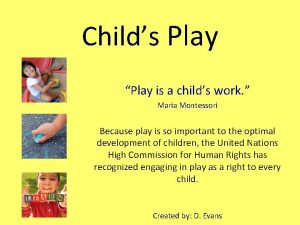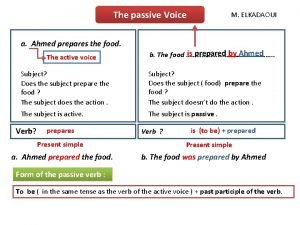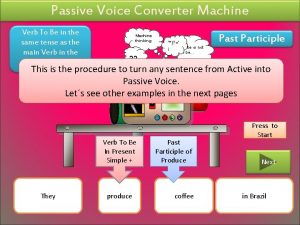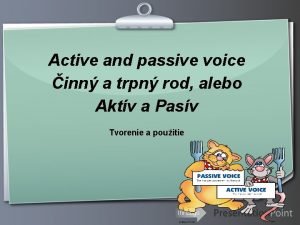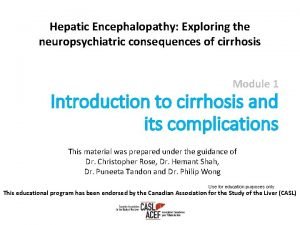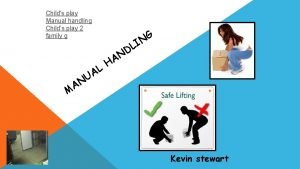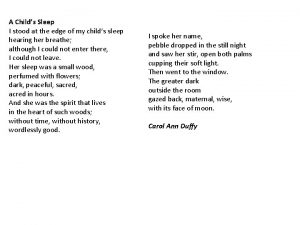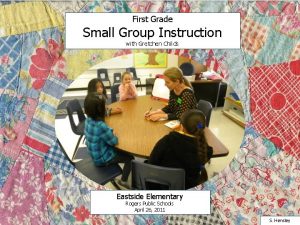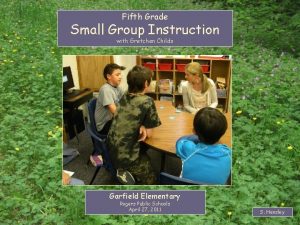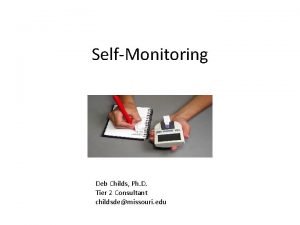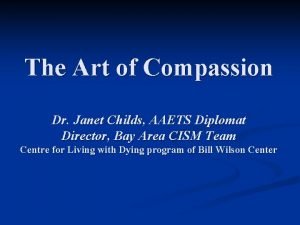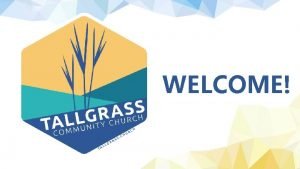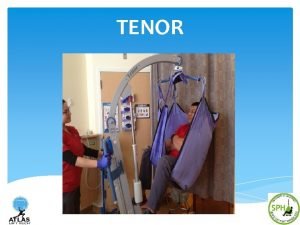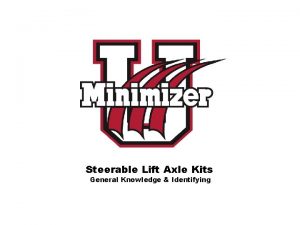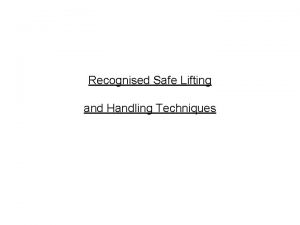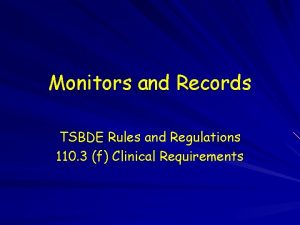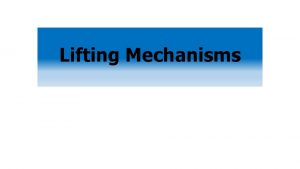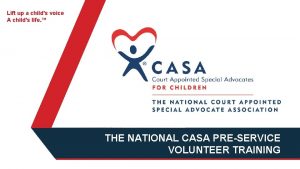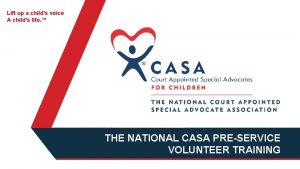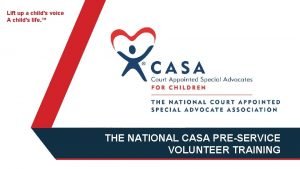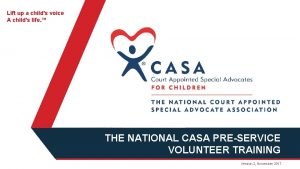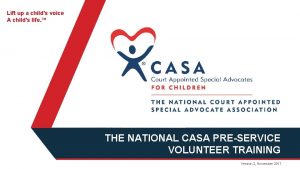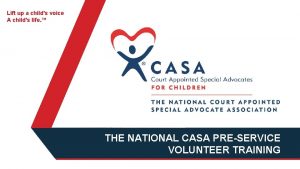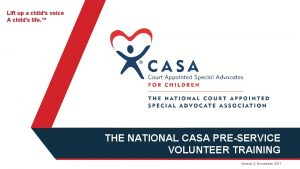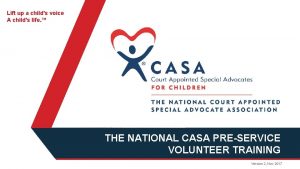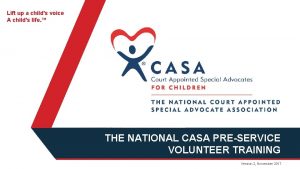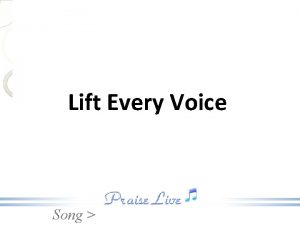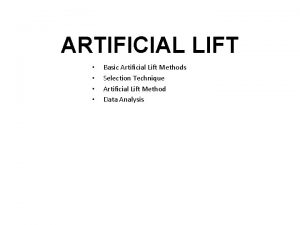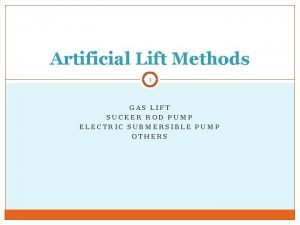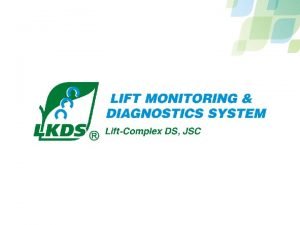Lift up a childs voice A childs life







































- Slides: 39

Lift up a child's voice A child's life. ™ THE NATIONAL CASA PRE-SERVICE VOLUNTEER TRAINING

Chapter 5: Substance Abuse & Cultural Competence Pre-Work Recap, Substance Abuse Chapter Overview & Competencies Skill Building: Cultural Competence Working Chapter Wrap-Up: a Case Review & Evaluation Chapter 6: Pre-Work 2

Chapter 5: Pre-Work Recap üRead the information on substance abuse üRead the information about “Commonly Used Drugs by National Institute on Drug Abuse” üRead about diversity, National CASA Vision and Guiding Principles üRead the “Cultural Competence Glossary” üRead the information on Disproportionality and Disproportionality Statistics üRead the “Local Disproportionality Statistics” 3

Chapter 5: Pre-Work Recap üRead the initial case notes for the Lavender Case üRead the sample court reports üRead the examples of good and bad court reports 4

Chapter 5: Overview This chapter explores the importance of cultural competence in the CASA/GAL volunteer role. You’ll also learn how substance abuse can affect parenting and you’ll continue to apply your new knowledge and skills in a case simulation. 5

Chapter 5: Competencies Competency Category Foundation of Knowledge, Skills, Attributes, Behavior Development in Chapter 5 Understands the ways substance abuse can affect children and families Knows the importance of being aware of resources in the community that assist with substance abuse Cultural Knows strategies and steps to take to increase cultural competency Competency skills and demonstrate culturally competent child advocacy Understands the root causes of disproportionate representation of children of color in the child welfare system and the disparate outcomes children of color experience Communication Understands the importance of speaking and writing clearly and concisely 6

Chapter 5: Substance Abuse & Cultural Competence Pre-Work Recap, Substance Abuse Chapter Overview & Competencies Skill Building: Cultural Competence Working Chapter Wrap-Up: a Case Review & Evaluation Chapter 6: Pre-Work 7

Chapter 5: Substance Abuse 5 A 1 B Understanding Substance Abuse 8

Chapter 5: Can the Child Return Home? 5 A Key points to consider: • The parent’s ability to function in a caregiving role • The child’s health, development and age • Parental history of substance abuse & treatment • Safety of the home • Family supports • Available treatment resources • Treatment prognosis and/or length of sobriety 9

Chapter 5: Substance Abuse 5 A As a CASA/GAL volunteer: üEducate yourself about the power of addiction & about resources üSupport those family members who are willing to deal with the substance abuse problem 10

Chapter 5: Substance Abuse & Cultural Competence 1 B 5 B Substance Abuse & Parenting 11

Chapter 5: Effects of Substance Abuse on Parenting 5 C [ Watch the following video ] Saving Kids: Children of Addicts What would be the challenges of advocating for a family with parental substance abuse? 12

Chapter 5: Finding A Balance – Shannon’s Story 5 D • Shannon was removed from her mother, Caterina’s custody for drunk driving, when 1 -year old • Shannon was placed in foster care with Nathan and Marie for 16 months • Caterina successfully completes de-addiction treatment for alcohol • Nathan and Marie support her, furnish an apartment and facilitate church visits 13

Chapter 5: Finding A Balance – Shannon’s Story 5 D • Shannon is returned to her mother when 28 months old • After a little more than a year, Caterina relapsed and was transported to the emergency room • Shannon stays with Nathan and Marie • Caterina completes her treatment successfully again • Should Shannon return to Caterina? OR • Should Caterina’s parental rights be terminated so that Nathan and Marie can adopt? 14

Chapter 5: Substance Abuse 5 D Working with Families - Finding a Balance 15

Chapter 5: Substance Abuse & Cultural Competence Pre-Work Recap, Substance Abuse Chapter Overview & Competencies Skill Building: Cultural Competence Working Chapter Wrap-Up: a Case Review & Evaluation Chapter 6: Pre-Work 16

Chapter 5: What Is Culture? 5 E • Culture is a learned pattern of customs, beliefs and behaviors, socially acquired and socially transmitted through symbols and widely shared meanings • Through culture, people and groups define themselves, conform to society's shared values, and contribute to society 17

Chapter 5: Culture is Like an Iceberg 5 E There are parts we can see, and parts we can’t see but know are there: • The visible parts include dress, music, food & games • The invisible parts include unwritten rules guiding patterns of speech, concepts of time and the meanings of body language 18

Chapter 5: Diversity and Cultural Competence 5 E Diversity - Refers to differences or variety in people’s identities or experiences: ethnicity, race, national origin, language, gender, religion, ability, sexual orientation, socioeconomic class and so on Cultural competence - Refers to the ability to work effectively with people from a broad range of backgrounds, experiences and viewpoints 19

Chapter 5: Skill Building: Cultural Competence 1 B 5 E Understanding Culture 20

Chapter 5: Skill Building: Cultural Competence 1 B 5 F The Value of Diversity 21

Chapter 5: National CASA Association Vision 5 F The National Court Appointed Special Advocate Association “stands up” for abused and neglected children. Building on our legacy of quality advocacy, we acknowledge the need to understand, respect and celebrate diversity, including race, gender, religion, national origin, ethnicity, sexual orientation, socioeconomic status and the presence of a sensory, mental or physical disability. We also value diverse viewpoints, life experiences, talents and ideas. 22

Chapter 5: Guiding Principles 5 F • Ethnic and cultural background influences an individual’s attitudes, beliefs, values and behaviors • Each family’s characteristics reflect adaptations to its primary culture and the majority culture, the family’s unique environment and the composite of the people and needs within it • A child can be best served by a CASA/GAL volunteer who is culturally competent and who has personal experience and work experience in the child’s own culture(s) 23

Chapter 5: Guiding Principles 5 F • To understand a child, a person should understand cultural differences and the impact they have on family dynamics • No cultural group is homogenous; within every group there is great diversity • Families have similarities yet are all unique • In order to be culturally sensitive to another person or group, it is necessary to evaluate how each person’s culture impacts his/her behavior 24

Chapter 5: Guiding Principles 5 F • As a person learns about the characteristic traits of another cultural group, he/she should remember to view each person as an individual • Most people like to feel that they have compassion for others and that there are new things they can learn • Value judgments should not be made about another person’s culture • It is in the best interest of children to have volunteers who reflect the characteristics (i. e. , ethnicity, national origin, race, gender, religion, sexual orientation, physical ability and socioeconomic status) of the population served 25

Chapter 5: Disproportionality 5 G Disproportionality is the experience of overrepresentation or underrepresentation of various groups in different social, political or economic institutions. 26

Chapter 5: Disproportionality in Child Welfare 5 G Statistically: • There is no difference among races in the likelihood that a parent will abuse or neglect a child • There is a great difference among races in the likelihood that a child will be removed from home • African American, American Indian & Native Alaskan children and children of two or more races are overrepresented in the system 27

Chapter 5: Skill Building: Cultural Competence 5 G Disproportionality and Disparate Outcomes 28

Chapter 5: Substance Abuse & Cultural Competence Pre-Work Recap, Substance Abuse Chapter Overview & Competencies Skill Building: Cultural Competence Working Chapter Wrap-Up: a Case Review & Evaluation Chapter 6: Pre-Work 29

Chapter 5: Working a Case 5 H 1 B The Lavendar Case 30

Chapter 5: Case Study on Parent’s Substance Abuse 5 H Ø Three weeks ago, Lavender Bass, age 6, came into care following a complaint Ø The CPS investigator located the mother and child behind the bar where mother is employed Ø Mother, Susan Mailer, was passed out drunk sleeping in her parked car Ø Lavender was sitting in the shade of a nearby tree waiting for her mom to wake up and take her home Ø The police were called and mother arrested for public drunkenness 31

Chapter 5: Case Study on Parent’s Substance Abuse 5 H Ø Lavender was placed in foster care with Bonnie Matthews Ø Susan Mailer’s criminal record reflected a tendency toward violence Ø She’d been in a couple of physical fights in the bar where she’s employed Ø She’s also been arrested for dealing marijuana and was once caught huffing inhalants. Does Susan’s substance abuse pose a child safety issue for Lavender? If so, does removing Lavender from the home protect her? What are the other options? 32

Chapter 5: Working a Case 5 I 1 B Writing Effective Court Reports 33

Chapter 5: Writing Effective Court Reports 5 I Read the sample court reports in the Chapter 5 Handouts. • • Which statements are opinion-based? Which statements are fact-based? What’s missing from each example? What could be improved in each example Example #1: John Bass Example #2: Lavender Bass Example #3: Susan Mailer 34

Chapter 5: Substance Abuse & Cultural Competence Pre-Work Recap, Substance Abuse Chapter Overview & Competencies Skill Building: Cultural Competence Working Chapter Wrap-Up: a Case Review & Evaluation Chapter 6: Pre-Work 35

Chapter 5: Substance Abuse & Cultural Competence In this chapter, you learned about: ü Reasons why people abuse substances and ways that substance abuse can affect children and families ü Resources to help families struggling with substance abuse ü How culture affects your work as a CASA/GAL volunteer ü How diversity and cultural competence in CASA/GAL volunteers benefit children and families ü Causes of the disproportionate representation of children of color in foster care and the disparate outcomes that children of color experience in foster care ü How to write clear and fact-finding court reports 36

Chapter 5: Evaluation Please fill out the Chapter 5 volunteer training evaluation and give to the facilitator. 37

Chapter 6: Pre-Work • Read the information about “Understanding Domestic Violence” and the statistics about domestic violence • Complete the exercise called Sorting People: Can You Tell Somebody’s Race by Looking at Them? • Answer the following questions: ü How did you do? ü What surprised you about the exercise? ü Think about the cases you’ve worked on so far. Did you observe any stereotyping in the Black, Bleux, Greene or Lavender cases? If so, how did it affect the families? 38

Chapter 6: Pre-Work • Complete the Exploring Culture and Perceptions Activity and answer the listed questions • Read the article “Stereotyping vs. Cultural Competence” • Complete the Culturally Competent Child Advocacy Activity • Read the article “Tips on How to Become More Culturally Competent” • Complete the Individual Action Plan for Increasing Cultural Competence Activity by filling in the details in the Individual Action Plan • Read the initial case notes for the Amarillo Case 39
 Childs work childs play
Childs work childs play Active to passive pattern
Active to passive pattern Active tense chart
Active tense chart Passive to active voice converter
Passive to active voice converter Present continuous tense passive voice
Present continuous tense passive voice Passive verbs
Passive verbs Passive voice vs active voice
Passive voice vs active voice Karyn l childs
Karyn l childs Perceptual reasoning
Perceptual reasoning Chapter 15-16 catcher in the rye
Chapter 15-16 catcher in the rye Childs pugh mdcalc
Childs pugh mdcalc Megan serbian
Megan serbian Manual handling childs play
Manual handling childs play Kenna childs wikipedia
Kenna childs wikipedia Dee childs
Dee childs A child's sleep poem
A child's sleep poem Heather rawls
Heather rawls Gretchen childs
Gretchen childs Gretchen childs
Gretchen childs Deb childs
Deb childs Aaets
Aaets Lord i lift everything to you
Lord i lift everything to you Rejoice come and lift your hands
Rejoice come and lift your hands Precipitatoin
Precipitatoin Unto you i lift up my eyes
Unto you i lift up my eyes Airfoil characteristics
Airfoil characteristics Thermalling techniques
Thermalling techniques Tenor lift
Tenor lift Sun metro lift
Sun metro lift Bolt on lift axle kit
Bolt on lift axle kit Sissor lift training
Sissor lift training All types of simple machines
All types of simple machines Lifting
Lifting How lift is generated
How lift is generated Wingtip vortex
Wingtip vortex Lift drag thrust weight
Lift drag thrust weight Tsbde rules and regulations chapter 110
Tsbde rules and regulations chapter 110 Vex robotics lifting mechanisms
Vex robotics lifting mechanisms Lift trucks ports and terminal
Lift trucks ports and terminal Lift fan drive shaft
Lift fan drive shaft
